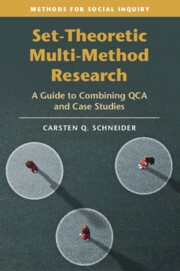Refine search
Actions for selected content:
114 results
Technological advancement of floating solar photovoltaic system: Design, efficiency and environmental effects
-
- Journal:
- Cambridge Prisms: Energy Transitions / Volume 1 / 2025
- Published online by Cambridge University Press:
- 14 November 2025, e6
-
- Article
-
- You have access
- Open access
- HTML
- Export citation
Does Ethnopolitical Exclusion Cause Civil War Onset via Grievances? Evidence from 15 Case Studies
-
- Journal:
- Perspectives on Politics , First View
- Published online by Cambridge University Press:
- 14 November 2025, pp. 1-18
-
- Article
-
- You have access
- Open access
- HTML
- Export citation
Chapter 5 - Conversation Content and Memory
-
- Book:
- Conversation Memory
- Published online:
- 09 October 2025
- Print publication:
- 23 October 2025, pp 59-78
-
- Chapter
- Export citation
5 - Big Experiments
-
- Book:
- Big Data in the Psychological Sciences
- Published online:
- 23 October 2025
- Print publication:
- 23 October 2025, pp 70-91
-
- Chapter
- Export citation
Part I - Intracultural Ethnography
-
- Book:
- Ethnography in International Business
- Published online:
- 21 October 2025
- Print publication:
- 09 October 2025, pp 27-124
-
- Chapter
- Export citation
Chapter 3 - Transformative learning through dance-play and drawing-telling
-
-
- Book:
- The Arts and Meaning-Making with Children
- Published online:
- 11 September 2025
- Print publication:
- 25 September 2025, pp 43-65
-
- Chapter
- Export citation
2 - Theory and Methods
-
-
- Book:
- Governing Climate Change Loss and Damage
- Published online:
- 10 June 2025
- Print publication:
- 26 June 2025, pp 25-49
-
- Chapter
-
- You have access
- Open access
- HTML
- Export citation
1 - Introduction
-
-
- Book:
- Governing Climate Change Loss and Damage
- Published online:
- 10 June 2025
- Print publication:
- 26 June 2025, pp 1-24
-
- Chapter
-
- You have access
- Open access
- HTML
- Export citation
13 - Rivers and Wetland Systems
- from Part IV - Managing Connectivity
-
-
- Book:
- Connectivity in Geomorphology
- Published online:
- 10 April 2025
- Print publication:
- 17 April 2025, pp 314-354
-
- Chapter
- Export citation
Pornography in Young Adults: A Gateway to Conduct Disorder?
-
- Journal:
- International Annals of Criminology / Volume 63 / Issue 1 / March 2025
- Published online by Cambridge University Press:
- 25 July 2025, pp. 200-213
- Print publication:
- March 2025
-
- Article
- Export citation
Introduction
-
- Book:
- The Politics of International Norms
- Published online:
- 07 February 2025
- Print publication:
- 20 February 2025, pp 1-37
-
- Chapter
- Export citation
Chapter 6 - Principles and Guidelines for Teaching History
-
- Book:
- Teaching History in Higher Education
- Published online:
- 07 February 2025
- Print publication:
- 20 February 2025, pp 215-250
-
- Chapter
- Export citation
4 - Probing the Financial Statecraft of Borrowers through Comparative Cases
-
- Book:
- The Financial Statecraft of Borrowers
- Published online:
- 12 December 2024
- Print publication:
- 19 December 2024, pp 136-158
-
- Chapter
- Export citation

Set-Theoretic Multi-Method Research
- A Guide to Combining QCA and Case Studies
-
- Published online:
- 22 February 2024
- Print publication:
- 29 February 2024
7 - RIO as a Gateway to Case Selection
- from Part III - RIO as a Gateway
-
- Book:
- Regression Inside Out
- Published online:
- 21 March 2024
- Print publication:
- 22 February 2024, pp 127-171
-
- Chapter
- Export citation
7 - Philanthropy in Emerging Economies
-
-
- Book:
- Reimagining Philanthropy in the Global South
- Published online:
- 09 February 2024
- Print publication:
- 15 February 2024, pp 145-167
-
- Chapter
-
- You have access
- Open access
- HTML
- Export citation
5 - “Textbook Science” before and after Structure
- from Part II - Normal Science and Science Education
-
-
- Book:
- Kuhn's <i>The Structure of Scientific Revolutions</i> at 60
- Published online:
- 05 January 2024
- Print publication:
- 18 January 2024, pp 95-120
-
- Chapter
- Export citation
Bus Rapid Transit: End of trend in Latin America?
-
- Journal:
- Data & Policy / Volume 6 / 2024
- Published online by Cambridge University Press:
- 11 January 2024, e2
-
- Article
-
- You have access
- Open access
- HTML
- Export citation
6 - Practical possibilities and pedagogical approaches in early childhood education for sustainability
- from Part 1
-
-
- Book:
- Young Children and the Environment
- Published online:
- 05 January 2024
- Print publication:
- 05 January 2024, pp 120-142
-
- Chapter
- Export citation
8 - Case Studies of Political Regimes and the BRI
-
- Book:
- China's Chance to Lead
- Published online:
- 02 November 2023
- Print publication:
- 16 November 2023, pp 232-287
-
- Chapter
- Export citation
